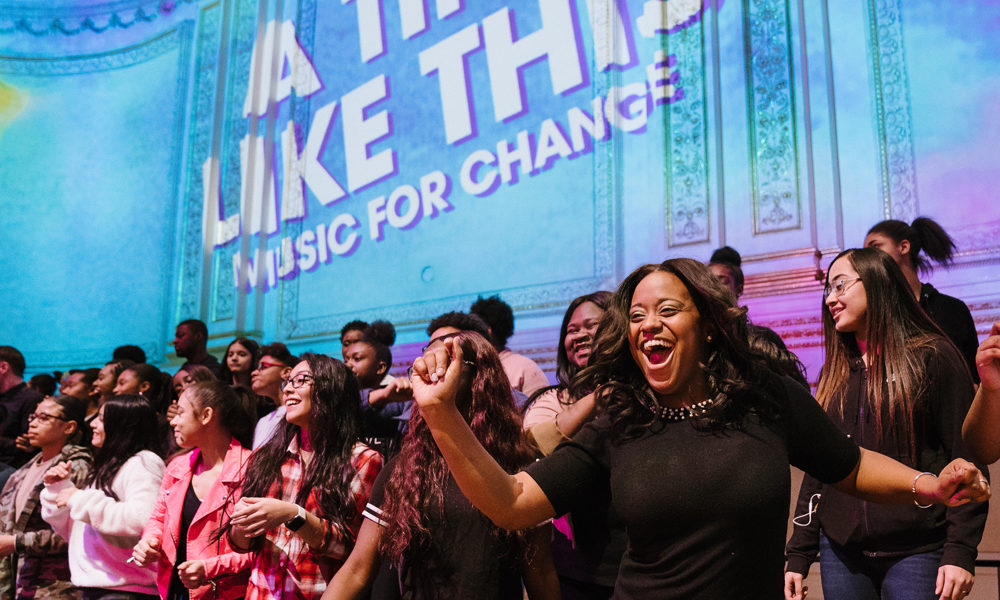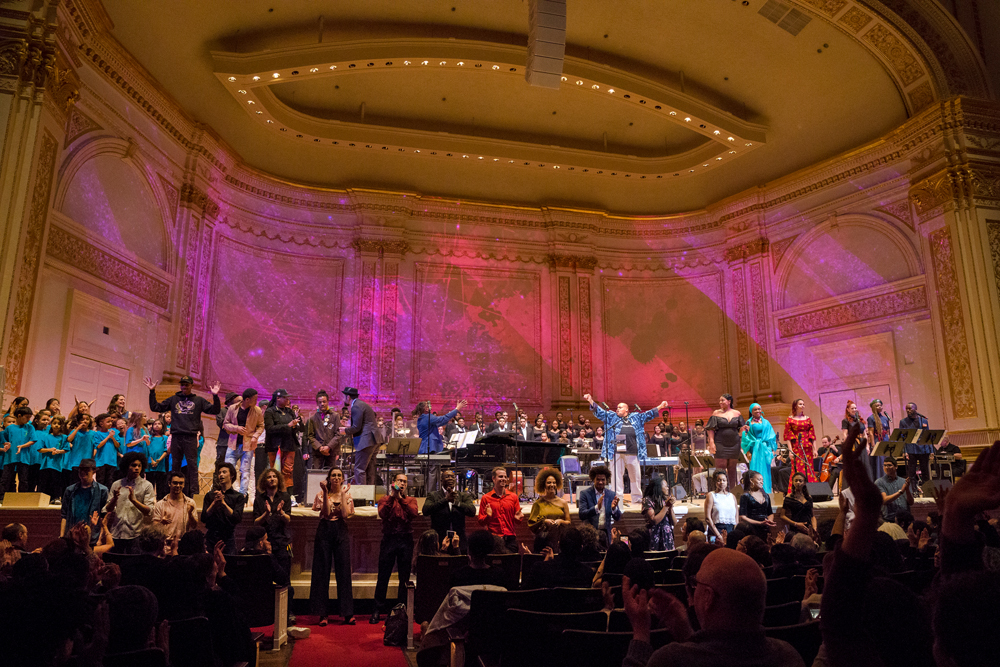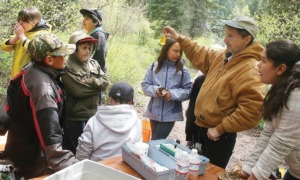
Fadi Kheir
New York City high school students rehearse for “A Time Like This: Music for Change” onstage at Carnegie Hall.
NEW YORK — The pianist jammed on the Steinway with such force, he stood up to play it. The rest of the orchestra swayed with the Songs of Solomon and Wadleigh High School choirs onstage at Carnegie Hall, singing a student composition about outcasts seeking change and second chances.
“Break the chains dragging us down,” their voices soared. “Close the door we marched through. Open one more to start anew.”
 But “A Time Like This: Music for Change” wasn’t just a concert Sunday. It honored the creative input of justice-impacted youth, on stage and behind the scenes, as New Yorkers of all ages performed civil rights-inspired songs alongside established artists.
But “A Time Like This: Music for Change” wasn’t just a concert Sunday. It honored the creative input of justice-impacted youth, on stage and behind the scenes, as New Yorkers of all ages performed civil rights-inspired songs alongside established artists.
“This is ground zero for the next biggest reform for our justice system,” said Create Justice participant Hasan Davis. “It’s going to be an art attack.”
Create Justice, a national initiative to advance juvenile justice reform through the arts, is a collaboration between Los Angeles-based Arts for Incarcerated Youth Network (AIYN) and Carnegie Hall. It hosts a forum, its third and final one, today and Tuesday.
About 2,000 people attended the concert, presented by Carnegie Hall’s Weill Music Institute.
Arts heal, open up youth
“Arts and corrections conversations are usually an adult conversation,” said AIYN executive director Kaile Shilling. “We’re trying to remind everyone to include young people.”
She considers art both a healing and preventative strategy for young people in the justice system. Through Create Justice, she has found a hunger for connection among others in the emerging youth arts-incarceration field, and has helped grow a national network of peers. Weill Music Institute, which operates multiple social impact programs rooted in music education, came aboard in 2016.
The arts more easily reach some kids than the city’s Administration for Children’s Services can, said Close to Home (C2H) Associate Commissioner John Dixon. The arts offer “a vehicle to really get those feelings out that otherwise would bring them back to where they were prior to our program,” he said at the concert’s after-party.
C2H houses justice-involved youth near their families in place of detention at distant facilities. Some rehabilitative arts programs are held on-site, like Voices Unbroken, which offers creative writing workshops. Carnegie Hall also receives C2H youth in its after-school musical programs and weekend open mic nights.

Richard Termine
Community members, students and songwriters from across New York City perform in “A Time Like This: Music for Change” at Carnegie Hall on Sunday.
Dixon has seen C2H youth who struggle with inconsistency show up at Carnegie Hall as scheduled and for the programs that they value. They may prefer opening up to mentors in the after-school setting, rather than checking in with their ACS case manager. Dixon said that C2H and Carnegie Hall strategize about how to co-manage these youth.
“It’s a little unorthodox. Our most difficult kids we probably want to supervise more, but we know that when they come [to Carnegie Hall], they’re going to get everything they need,” he said.
‘Invest time in us’
Jordan and Brian, 20-year-old justice-involved youth leaders at Carnegie Hall, stayed busy behind the scenes at the venue. They are producing an open mic and networking event for young people tonight. They call it “Speak the Truth, Connect the Youth.”
“What I wish people would know about all youth is the fact that we all could be great. All you gotta do is just invest time in us,” said Jordan, who enjoys writing lyrics. “Time and care, that’s it.”
Creative expression has helped Hasan Davis focus since he was a child. He was first arrested at 11 years old, followed by a few years on probation. He also struggled with ADHD and dyslexia growing up in poverty in the South.
As a preteen he found solace in writing, a practice he inherited from his mother, the writer and activist Alice Lovelace. His disabilities made writing a challenge at first. Davis remembers barely being able to grip the pen when his mother sat him down with a pad of paper the first time. Write whatever comes to mind, she instructed him.
“I was writing so hard and so frustrated that I was just ripping through page after page. I could barely read it when I was done,” he said. “But I felt like the whole world had lifted off me.”
Davis traveled from Kentucky to attend this event. He has traveled to the two previous forums that were part of Create Justice, the first a year ago in New York, the second in October in Los Angeles. A former commissioner of the Kentucky Department of Juvenile Justice, he now works as a theater artist and advocate who believes art is integral to the transformation of young people in crisis.
“By making young people our partners — our creative partners — in telling their own stories, we can help them become those people,” he said. His bracelet reads “Hope Dealer.”































